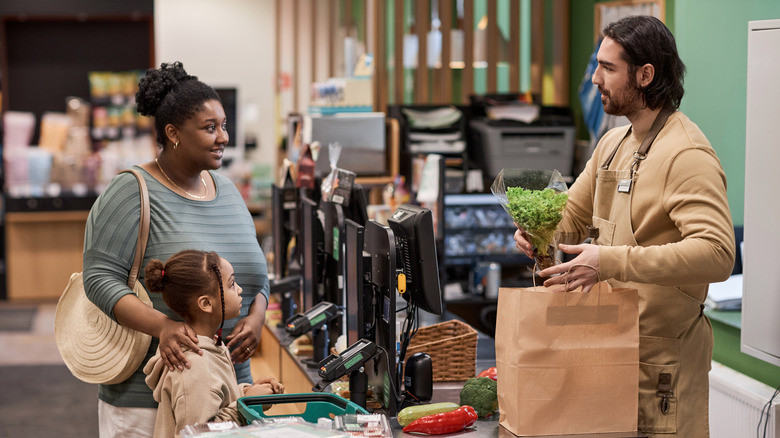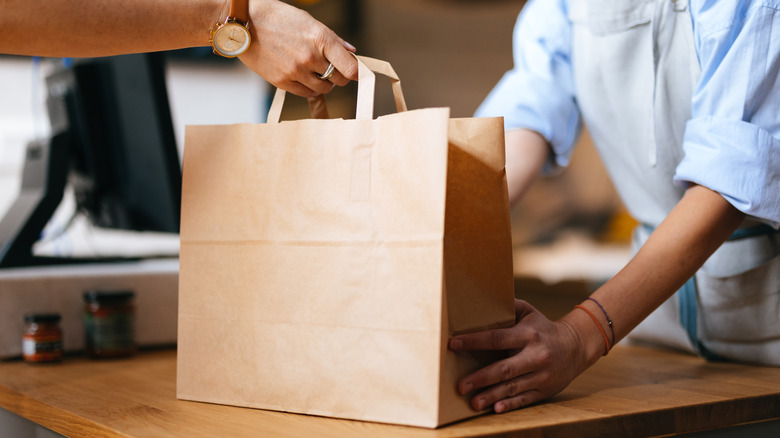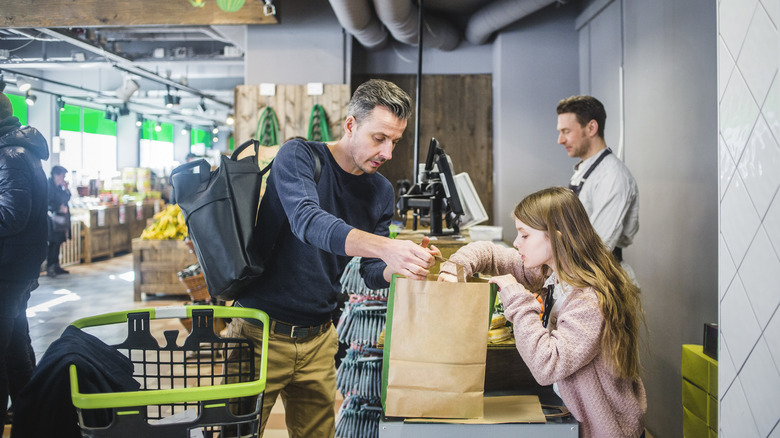The Checkout Technique To Make Sure Your Groceries Are Bagged Safely
Crushed salad greens and cracked eggs might be a rite of passage for inexperienced shoppers, but after you've been at it a while, such culinary casualties get old fast. Putting a stop to smashed groceries comes down to how you organize your items on the checkout conveyor belt. This strategy works whether you bag up your groceries or let the store's bagging person do it for you.
Here's the order of operations you should follow: Heavy and bulky items, like shelf-stable juices, dry noodles, and canned goods, go first. Lighter, more fragile items get put on the belt last. Additionally, frozen and refrigerated stuff should hang out in the same bag; delicate fruits and veggies also stick together like birds of a feather. Keep household goods, like cleaners and sponges, separate so that they don't end up in a bag with food items. Of course, in addition to how you bag your groceries, the type you use to carry them can also make a big difference.
Working with the bags
Before discussing how to load them up, it's worth going over your bag options. You want to pack as much as you can in each bag without overstuffing them. It's also good to gauge how much you think you can carry. If you're bagging your own groceries, rather than packing one large bag, it may be easier for you to carry two lighter ones. If someone from the store is packing up your items for you, ask them to separate your groceries into smaller bags to make them more manageable for you to carry.
As for the bags themselves, the standard store-issued plastic bag accommodates about 10 items. Double-bagging may be necessary if you have heavy items. Reusable cloth or plastic carry-along bags can sometimes hold twice as much (in some cases, up to 50 pounds). In other words, 15 to 20 items may go in your reusable carry-along bag. Additionally, if you're bringing reusable bags with you, you can line the bottom of each bag with a box that fits inside the bottom of the bag. Doing this reinforces the bottom of the bag while allowing you to have the convenience of carrying a bag by its handles. Handles make everything easier. Boxes make everything sturdier. The combination is a match made in grocery bagging heaven, particularly if you have to carry a heavy load of breakable items.
Tips for bagging your items
Ideally, you'll put like items with like items, such as cans with cans, on the belt together and in the bag together. However, that isn't always possible. If you don't have a box-lined bag, there are other ways to pack your groceries safely with one from the store. You can build a wall inside the bottom of the bag by lining the interior edges of it with boxes of pasta. Put any cans of crushed tomatoes inside the box walls, so the pasta surrounds them. This makes a sturdier base if you have to put something on top of the stack.
Additionally, if you're worried about breakage or adding too much weight to your current bag, you can put pasta sauce and other bottled items into a new bag. For safety's sake, consider wrapping glass bottles in some of the plastic bags from the bagging area. This provides cushioning and stops the bottles from breaking during transport.
Start a new bag for your frozen stuff, putting ready-made pie on the bottom and elevatable frozen pizza on top of that. Then any frozen veggies and mixed berries go in after that. Your fresh produce gets its own bag, as do any meats or deli items. Finally, you'll guarantee that you have eggs for omelets and cookies for dessert if you put those items in their own bags to prevent them from being crushed. With a little practice, you'll never have to worry about your groceries again.


